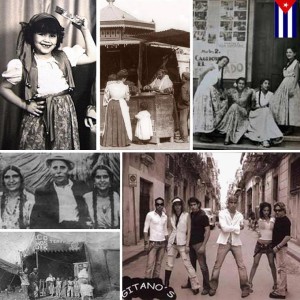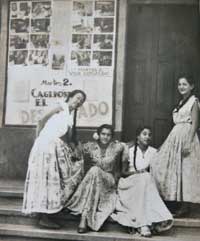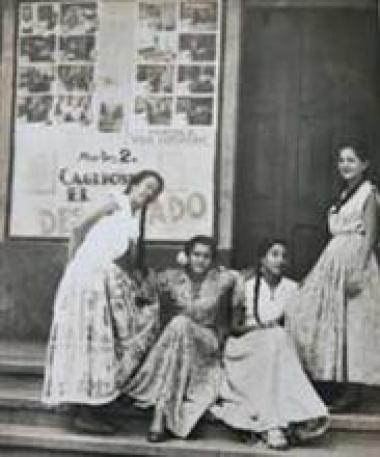 MI CUMBILA!, JARANA!, ANDOBA! ….INFLUENCIA GITANA EN CUBA.
MI CUMBILA!, JARANA!, ANDOBA! ….INFLUENCIA GITANA EN CUBA.
El etnólogo Fernando Ortiz afirmó que Cuba era un ajiaco por la diversidad de razas y culturas que influyeron en la formación de su nacionalidad. Y tiene toda la razón, la nacionalidad cubana se ha nutrido de casi todo tipo de inmigraciones y lo haremos con los gitanos que pisaron Cuba y han influenciado en nuestro suelo.
Aunque su presencia en tierra cubana se remonte a los tiempos de la colonia, según afirman los historiadores, la mayor oleada llegó a raíz de la II Guerra Mundial, cuando los nazis exterminaron, en los campos de concentración, a medio millón de seres pertenecientes a esa etnia en Europa Central.
Todo parece indicar que las migraciones masivas sucedieron en los albores del siglo XX, cuando varias familias o tribus gitanas llegaron junto a las oleadas de inmigrantes españoles que vinieron a probar fortuna. En Cuba, si bien los gitanos fueron menos discriminados que en otros lugares, también sufrieron lo suyo en este período. Hasta una ley, dictada en 1936, prohibió su ingreso a la Isla, algo que constituía un verdadero crimen, toda vez que en esos momentos muchos de ellos huían de España, donde fueron duramente perseguidos por el franquismo durante la Guerra Civil Española.
Referencias del tema en nuestra literatura las encontramos en libros como “La cubanita que nació con el siglo” donde nuestra escritora Renée Méndez Capote les dedica un espacio y también en la prensa, como en uno de los números de la revista “Carteles”, fechado en 1940, donde se publicó un reportaje que reseña cómo se refugiaron en los arrabales de la Habana de intramuros. Una de las fotos muestra sus carpas, las bellas mujeres ataviadas con vestidos típicos y los tocadores de guitarra española. Los habaneros los recibieron con una naturalidad no exenta de cierta curiosidad.
Muchos de ellos tenían la intención de utilizar a Cuba como trampolín para viajar a otros países, pero algunos se integraron, y sus descendientes encontraron en la isla, como ellos mismos expresaron, el único país donde podían vivir tranquilos.
Según diversos estudios, los gitanos o romaníes son un pueblo que procede originalmente de la India, aunque ha migrado por Asia, África, América y Europa, continente donde se ha concentrado un mayor número. Los gitanos, conservan su propia lengua, pero en muchas ocasiones hablan más de un idioma como resultado de su vida nómada. Sus hijos, si bien son inscritos en el país que nacen con nombres de esa lengua, llevan por el resto de sus vidas su patronímico propio gitano.
Por encima de todo aman la libertad, respetan y son fieles hasta morir al jefe de su tribu. Son extremadamente supersticiosos.
Aunque por su condición de nómadas se podían encontrar en cualquier lugar de la isla participando como artistas en el circo, como vendedores en ferias y parrandas, o improvisando chinchales y timbiriches para la venta de mercancías elaboradas incluso por ellos mismos, existen referencias documentadas que los ubican, en otros tiempos, en algunos centrales azucareros como el Chaparra y otras regiones del oriente cubano. También en la provincia de Las Villas era frecuente ver sus campamentos, como por ejemplo, a las afueras de Camajuaní.
En Cuba dejaron la huella de muchas de sus costumbres. Difundieron las ferias, los carnavales, el circo ambulante – llegaron a existir 42. Hay palabras de su lengua incorporadas a la jerga de los compositores del feeling de la década de 1940 y de la actual música bailable salsera… y en los dulces: el brazo gitano.
En las artes plásticas de este período (1925-1940) sin dudas Víctor Manuel García Valdez (1897-1969) con su “”Gitana Tropical”, pequeña pintura (46 x 38 cm) pintada sobre madera y premiada en el Salón de Pintores y Escultores de 1929, al igual que en otras obras, nos representa a una muchacha mestiza, más cercana al tipo “gitana” que a la cubana. De ahí su título.
El español hablado en Cuba, como es de esperar, no pudo escapar a este influjo “agitanador”, por lo que en el habla coloquial popular de nuestro país son numerosos los gitanismos. Como ejemplo de ello, a continuación relacionamos los siguientes:
acurdar (emborrachar), andoba (fulano), barín (bueno), berro (cólera, disgusto), birlar (robar), bisnar (vender), de butén (de maravilla, de primera), chiva (soplón, delator), chola (cabeza), chota (soplón), chusma (muchedumbre vulgar, coba (halago, adulación), cumbila (compañero, amigo), curda (embriaguez, borrachera), furnia (cueva), garito (casa de juego), guillarse (hacerse pasar por algo distinto de lo que se es, hacerse el tonto), jamar (comer), jarana (broma), jeta (cara), jiña (excremento), jiñar (defecar), jiribilla (salero, gracia), mangar (engañar), menda (yo), pargo (homosexual), pirabear (fornicar), pirar (marcharse, irse), puro,ra (padre, madre), sandunga (donaire, garbo), sornar (dormir) y otros.
En la actualidad existe la “Agrupación Flamenca Sangre Gitana” integrada por unas 130 niñas y adolescentes de Camagüey y dirigidas por la también fundadora Yaineris Torres Pérez, que desarrolla una interesante labor con la amorosa pasión por ese tipo de expresión cultural. Al menos yo, “el menda”, así lo considero…
 MY CUMBILA!, CURDA!, ANDOBA! …. GYPSY INFLUENCE IN CUBA.
MY CUMBILA!, CURDA!, ANDOBA! …. GYPSY INFLUENCE IN CUBA.
The ethnologist Fernando Ortiz affirmed that Cuba was an Ajiaco because of the diversity of races and cultures that influenced the formation of his nationality. And he is absolutely right, the Cuban nationality has been nourished by almost all types of immigrations and we will do it with the gypsies who stepped on Cuba and have influenced our soil.
Although its presence on Cuban soil goes back to colonial times, according to historians, the greatest surge came in the wake of World War II, when the Nazis exterminated, in the concentration camps, half a million people belonging to that ethnic group in Central Europe.
Everything seems to indicate that massive migrations happened at the dawn of the 20th century, when several families or gypsy tribes arrived alongside the waves of Spanish immigrants who came to try their luck. In Cuba, although the gypsies were less discriminated than in other places, they also suffered during this period. Until a law, dictated in 1936, prohibited its entrance to the Island, something that constituted a true crime, since in those moments many of them fled from Spain, where they were harshly persecuted by the Franco during the Spanish Civil War.
References of the subject in our literature are found in books like “La cubanita that was born with the century” where our writer Renée Méndez Capote dedicates a space to them and also in the press, as in one of the issues of the magazine “Carteles”, dated in 1940, where a report was published that describes how they took refuge in the suburbs of Havana in the inner city. One of the photos shows their tents, the beautiful women dressed in typical dresses and the Spanish guitar players. The Habaneros received them with a naturalness that was not without curiosity.
Many of them had the intention to use Cuba as a springboard to travel to other countries, but some were integrated, and their descendants found on the island, as they expressed themselves, the only country where they could live in peace.
According to various studies, gypsies or Roma are a people originally from India, although they have migrated to Asia, Africa, America and Europe, a continent where a greater number have been concentrated. Gypsies retain their own language, but often speak more than one language as a result of their nomadic life. Their children, although they are registered in the country that are born with names of that language, carry for the rest of their lives their own gypsy patronym.
Above all love freedom, respect and are faithful to die the head of his tribe. They are extremely superstitious.
Although nomads could be found anywhere in the island participating as artists in the circus, as vendors in fairs and parrandas, or improvising chinchales and timbiriches for the sale of goods made even by themselves, there are documented references that the located, in other times, in some sugar mills such as Chaparra and other regions of eastern Cuba. Also in the province of Las Villas it was common to see their camps, as, for example, on the outskirts of Camajuaní.
In Cuba they left the mark of many of their customs. They spread the fairs, the carnivals, the traveling circus – they came into existence 42. There are words of their language incorporated into the jargon of the composers of the 1940s feeling and the current danceable salsa music … and in the sweets: the arm Gypsy.
In the plastic arts of this period (1925-1940) without a doubt Víctor Manuel García Valdez (1897-1969) with his “” Tropical Gitana “, small painting (46 x 38 cm) painted on wood and awarded in the Painters Salon and Sculptors of 1929, as in other works, represents a mestizo girl, closer to the “gypsy” type than to the Cuban one. Hence its title.
The Spanish spoken in Cuba, as expected, could not escape this “agitator” influence, so in the popular colloquial speech of our country there are many gypsies. As an example of this, next we relate the following:
acurdar (emborrachar), andoba (fulano), barín (bueno), berro (cólera, disgusto), birlar (robar), bisnar (vender), de butén (de maravilla, de primera), chiva (soplón, delator), chola (cabeza), chota (soplón), chusma (muchedumbre vulgar, coba (halago, adulación), cumbila (compañero, amigo), curda (embriaguez, borrachera), furnia (cueva), garito (casa de juego), guillarse (hacerse pasar por algo distinto de lo que se es, hacerse el tonto), jamar (comer), jarana (broma), jeta (cara), jiña (excremento), jiñar (defecar), jiribilla (salero, gracia), mangar (engañar), menda (yo), pargo (homosexual), pirabear (fornicar), pirar (marcharse, irse), puro,ra (padre, madre), sandunga (donaire, garbo), sornar (dormir) and others.
At present, there is the “Agrupación Flamenca Sangre Gitana” composed of about 130 girls and adolescents from Camagüey and directed by the founder, Yaineris Torres Pérez, who develops an interesting work with a passionate passion for this type of cultural expression. At least, “el menda”, I consider it …
Agencias/ Memorias Cubanas/ Derubín Jácome/ Extractos/ Internet Photos/ Arnoldo Varona/ www.thecubanhistory.com
THE CUBAN HISTORY, HOLLYWOOD.








